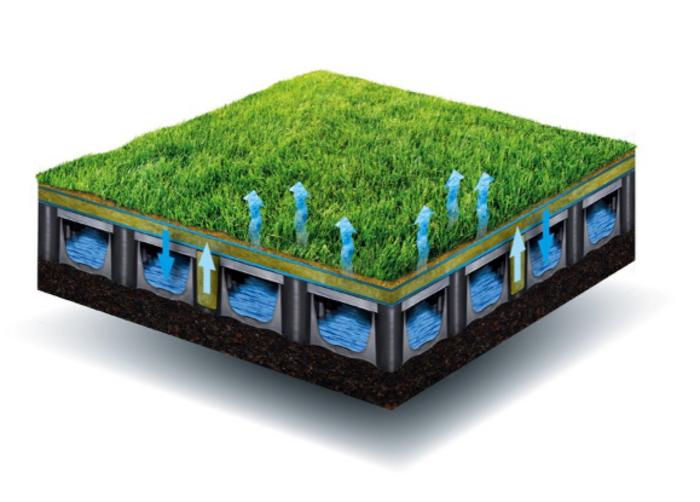For those living in cities, space to play sports outside can be a scarcity. Recently, natural grass in parks or public sports courts has often been replaced with more durable artificial turf to allow heavy consecutive use.

Credit: Image: Permavoid
For those living in cities, space to play sports outside can be a scarcity. Recently, natural grass in parks or public sports courts has often been replaced with more durable artificial turf to allow heavy consecutive use.
There are, however, downsides to this practice, both for people and for cities as a whole. Now, scientists in the Netherlands have set out to change that by integrating a subsurface water storage and capillary irrigation system under artificial turf sports fields.
“Here we show that including a subsurface water storage and capillary irrigation system in artificial turf fields can lead to significantly lower surface temperatures compared to conventional artificial turf fields,” said Dr Marjolein van Huijgevoort, a hydrologist at KWR Water Research Institute and first author of the article published in Frontiers in Sustainable Cities. “With circular on-site water management below the field, a significant evaporative cooling effect is achieved.”
Cooler turf and air
The artificial turf and subbase system includes an open water storage layer directly underneath the artificial turf and shockpad. In this water layer, rainwater is stored. This water retention system contains cylinders that transport the stored water back up to the surface of the artificial turf, where it evaporates.
“The process of evaporative cooling and capillary rise is controlled by natural processes and weather conditions, so water only evaporates when there is demand for cooling,” van Huijgevoort explained.
Conventional artificial turf can reach surface temperatures of up to 70°C on sunny days. These temperatures are high enough to cause burn injuries and trigger heat related illnesses, ranging from mild rashes to potentially life-threatening conditions like heat stroke.
In a field experiment conducted in Amsterdam, the researchers found that when conventional turf was replaced with the self-cooling turf, temperatures dropped. They reported that on a particularly hot day in June 2020, the cooled turf reached a surface temperature of 37°C – just 1.7°C higher than natural grass – whereas surface temperatures of the conventional artificial turf reached 62.5°C.
Above the plots, temperatures also differed. “We found lower air temperatures 75cm above the cooled plots compared to conventional artificial turf fields, especially during the night,” said van Huijgevoort. “This is a first indication that the cooled plots contribute less to the urban heat island effect.”
Artificial with natural advantages
The cooling turf combines advantages of artificial turf and natural grass: It is durable, keeps itself cool, and offers a healthy environment to play sports. It can also store almost as much rainwater as natural grass. The field’s rainwater retention capacity also reduces stormwater drainage, which helps mitigate urban flooding. During periods when it does not rain enough, extra water can be added directly into the system. Alternatively, it could be watered like natural grass.
Installation costs, however, can be up to twice as expensive as for conventional artificial turf. The researchers said that a full-scale cost-benefit analysis should be undertaken to find out the true value of the investment.
Further research also needs to confirm how cooling turf could impact the surrounding area and cities as a whole. Learning more about the benefits of the turf in different climates and using different storage sizes, materials, and infills is also necessary to find the optimal combination, the researchers pointed out.
Initial results, however, are promising. “People in urban areas, especially children, have a growing need for sport and play facilities,” van Huijgevoort concluded. “With this work we show the benefits of the subsurface water storage and capillary irrigation system without negative effects of artificial turf fields.”
Journal
Frontiers in Sustainable Cities
Method of Research
Experimental study
Subject of Research
Not applicable
Article Title
Climate adaptive solution for artificial turf in cities: integrated rainwater storage and evaporative cooling
Article Publication Date
9-Jul-2024
COI Statement
The authors declare that the research was conducted in the absence of any commercial or financial relationships that could be construed as a potential conflict of interest.



